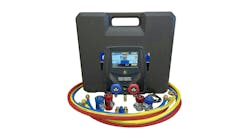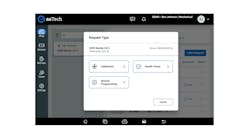For years, manufacturers of bearings have known that the best wheel end bearing settings are at light preload. Yet, they have been steadfast in recommending endplay settings because a means for measuring preload settings was not available.
All the accepted procedures for wheel end bearing adjustment conclude with statements requiring measurement of the resulting setting with a dial indicator. Many maintenance operations fail to complete that final and vital step.
Out-of-tolerance wheel end bearing settings can take a long time to cause failures. These can be catastrophic, making it difficult at best to trace the origin of the failure.
It is widely understood that the progression of failure usually involves seal failure that may not be the root cause when the bearings are set too loose or too tight.
Several major manufacturers of tapered roller bearings subscribe to the accompanying chart of bearing life versus bearing setting. Clearly, the best life is in the narrow spike that represents light preload.
BEARING SETTING
The Society of Automotive Engineers published Surface Vehicle Recommended Practice J2535 as a guide that shows optimum life at preload settings of 250 pounds for steer axles and 500 pounds for drive and trailer axles.
There is a wide range of acceptable, but not optimal, bearing settings that extend into endplay, as long as the setting value is not enough to encourage seal wear or roller misalignment.
The Technology and Maintenance Council’s RP 618A, a standard for bearing adjustment procedure, permits endplay to a maximum of 0.005 inch. (A fine human hair has a diameter in the range of 0.003 to 0.005 inch.) Many of the bearing technology experts believe this to be excessive.
This standard refers to the adjustment of jam nuts and calls for dial indicator measurement and fine-tuning each adjustment to meet the required range.
In our lab, we’ve found it typical that the step of securing a jam nut in accordance with the procedure changes the setting by tightening the inner nut by approximately 0.009 inch.
MEASUREMENT NEED
Procedures recommended with single nut products do not have this added potential for error. However, they too require measurement for verification of the result.
Regardless of what setting is chosen, there is a need to verify the result on every wheel end, not just on a sampling. To skip this step is dangerous.
Careful measurement of bearing settings must be done with accurate equipment and procedures. Those that believe they can determine acceptable settings by rocking the wheel and “feeling” the play in the wheel end simply do not understand what is required and will often accept out-of-tolerance settings.
One final point: Standards and practices serve to raise the minimum quality, performance and safety in an industry and can be an important part of addressing serious problems. These standards and practices typically reflect the state-of-the-art of technology that is available when they are written.
At the same time, industry standards and practices also can breed an increase in complacency. “We’re doing what we’ve done for years, so that’s the best we can do,” is an attitude that must be avoided.
Advances in technology often enable improvements well beyond those achievable by following accepted industry standards and practices.
When it comes to vehicle wheel end service, this is a good time for vehicle maintenance leaders to revisit their current operations and explore how to leverage bearing adjustment and measurement technologies to maximize their wheel safety.




